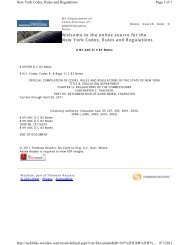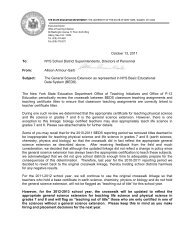ESL Learning Standards - Higher Ed - New York State Education ...
ESL Learning Standards - Higher Ed - New York State Education ...
ESL Learning Standards - Higher Ed - New York State Education ...
You also want an ePaper? Increase the reach of your titles
YUMPU automatically turns print PDFs into web optimized ePapers that Google loves.
Standard 3:<br />
Students will listen, speak, read, and write in English for<br />
critical analysis and evaluation.<br />
Intermediate Grade Sample Classroom Tasks:<br />
English Proficiency Level<br />
Beginning<br />
Students read or listen to a brief retelling of the Rosa Parks<br />
bus incident. They role-play Rosa Parks’ taking a<br />
stand/being arrested, using the vocabulary from the text.<br />
Teacher prepares an outline of a T-chart showing Parks’<br />
perspective and the bus driver’s or the government’s perspective.<br />
Performance indicators: 3<br />
Intermediate<br />
Students watch movie, The Long Walk Home. In small<br />
groups, they speculate as to what is nonfiction and what is<br />
Hollywood fiction. Teacher provides groups with simple<br />
reference material to check facts. Groups compare the fictional<br />
representation with the facts. Whole class discusses<br />
rationale for fictional embellishments. Students then prepare<br />
role-plays as in Beginning task.<br />
Performance indicators: 1, 2, 5<br />
<strong>ESL</strong><br />
3<br />
Interm<br />
Students brainstorm a list of their favorite TV programs.<br />
Using this list, teacher prepares an inventory form for students<br />
to use to keep track of their TV viewing. Students<br />
complete inventory over a period of two weeks. Class discusses<br />
viewing habits, tallies the inventories, and creates a<br />
graph. Each student writes a summary of results (e.g.,<br />
favorite programs in the class, number of hours watched<br />
per day or week, average number of hours per student,<br />
preferred hours for watching TV).<br />
Performance indicators: 1, 7<br />
Students cut 10 advertisements from various types of magazines<br />
and newspapers, in English or in their native language.<br />
Students mount and number the ads on poster<br />
paper. They complete a teacher-made chart that indicates<br />
product and target audience for each ad. Students present<br />
ad posters and share information from charts. Class discusses<br />
differences of opinion during presentations through<br />
question-and-answer session.<br />
Performance indicators: 1, 2, 3, 7, 9<br />
Students complete Beginning task. Class designs a survey to<br />
assess TV interests of other students, using the categories<br />
from Beginning task. Each student interviews five students,<br />
tabulates data, and graphs results. Students write essays<br />
comparing their TV interests with those of the peers they<br />
interviewed, incorporating reflections on similarities and<br />
differences. Essays are shared in class.<br />
Performance indicators: 1, 2, 3, 7, 9<br />
Students complete Beginning task. Teacher hangs posters.<br />
Students develop categories for products displayed in<br />
posters and regroup advertisements by category such as<br />
target audience, product, medium (color or black-and-white<br />
photos, drawings), or purpose (sell, inform, persuade). In<br />
small groups, students discuss which advertisement in each<br />
category is most effective and why, and develop a list of<br />
criteria for effective ads. Small groups compare results and<br />
discuss similarities and differences.<br />
Performance indicators: 1, 2, 3, 7, 9<br />
In small groups, students move through three classroom<br />
centers dedicated to a single topic (Civil War): 1) maps,<br />
photos, timeline; 2) encyclopedias and reference books<br />
with relevant pages flagged; 3) textbooks, trade books,<br />
adapted text. At each center small groups complete a teacher-made<br />
activity sheet that asks for particular information,<br />
varied for each center. Class discusses answers and talks<br />
about how and where they found the answers. Students<br />
rate centers and materials on a simple scale (e.g., quality,<br />
quantity, clarity, ease of use, etc.).<br />
Performance indicators: 2, 3, 5, 7, 9<br />
After completing Beginning task, students brainstorm strategies<br />
(e.g., using pictures, bold text, headings, etc.) for<br />
obtaining information from materials in the center rated the<br />
most difficult. They repeat the process for each of the centers.<br />
In small groups, students complete a second activity<br />
sheet for each center, employing new strategies. Again,<br />
they rate centers on a simple scale and answer an openended<br />
question assessing their preferences and abilities in<br />
using various materials and strategies.<br />
Performance indicators: 1, 2, 3, 5, 7, 9<br />
76 <strong>Learning</strong> <strong>Standards</strong> for <strong>ESL</strong>
















